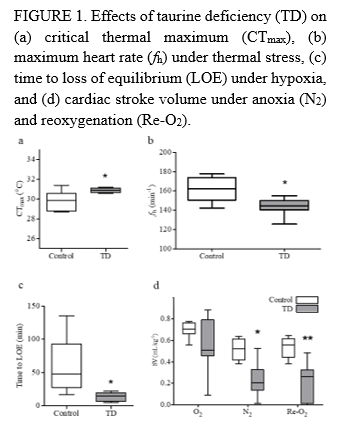DIET-INDUCED TAURINE DEFICIENCY INCREASES THERMAL TOLERANCE AND HYPOXIA SENSITIVITY IN BROOK TROUT: CARDIOVASCULAR MECHANISMS
Abstract: Taurine is a beta amino acid found in high concentrations inside vertebrate heart cells where it functions primarily as an osmolyte . M ammals tightly regulate cellular taurine levels and deficiency is associated with cardiomyopathy and disruptions in energy metabolism. Taurine levels are far more dynamic in freshwater fish but the impact of taurine fluctuations have not been assessed. We developed a taurine-deficient (TD)
brook trout model system using an experimental diet rich in a natural competitive inhibitor of taurine uptake . Cardiovascular function limits environmental stress tolerance in fish so w e hypothesized that TD animals would exhibit impaired cardiac function and
increased sensitivity to acute thermal and hypoxic
environmental stress.
Heart taurine concentration decreased by 21% after 4 weeks with the experimental feed . TD fish were less sensitive to acute thermal stress (Fig 1a)
despite having a lower maximum heart rate at high temperatures. TD fish were more sensitive to acute hypoxia in vivo , and this was mirrored in vitro , as
cardiac stroke volume collapsed in anoxic perfused hearts. M itochondria from TD hearts
were relatively uncoupled,
complex IV function was impaired, and the expression of its COX3 subunit
was reduced . High concentrations of intracellular taurine appear necessary to support maximum cardiac function and
aerobic metabolism in brook trout.
We have demonstrated that a diet additive can uncouple acute thermal tolerance from hypoxia tolerance via changes in cardiac taurine content. Using the mechanisms identified here, we are now designing additive mixtures to rapidly (within days) enhance both thermal and hypoxia tolerance to improve survivorship under intensive culture conditions .
